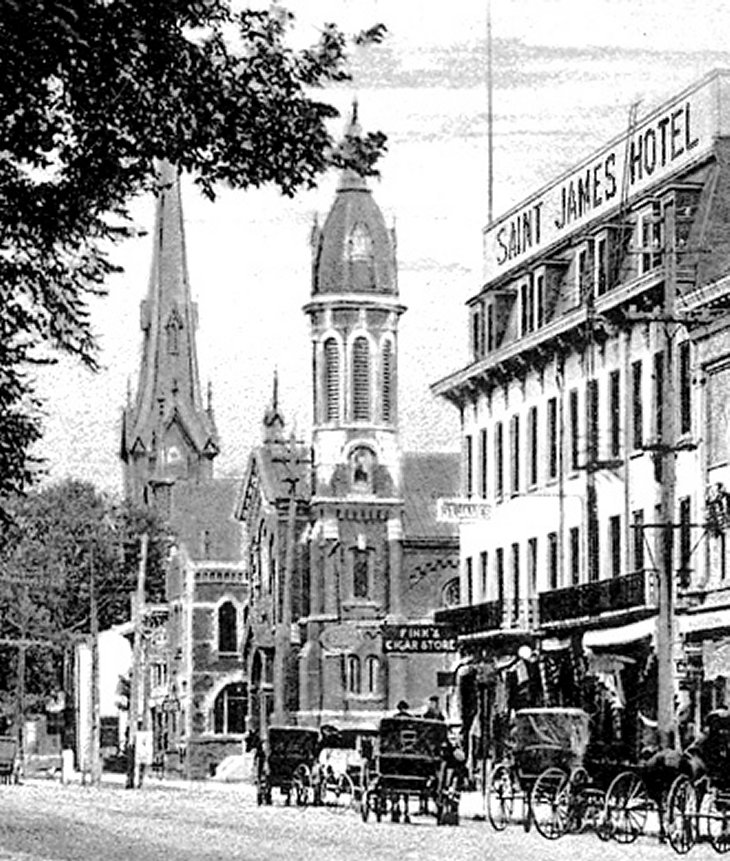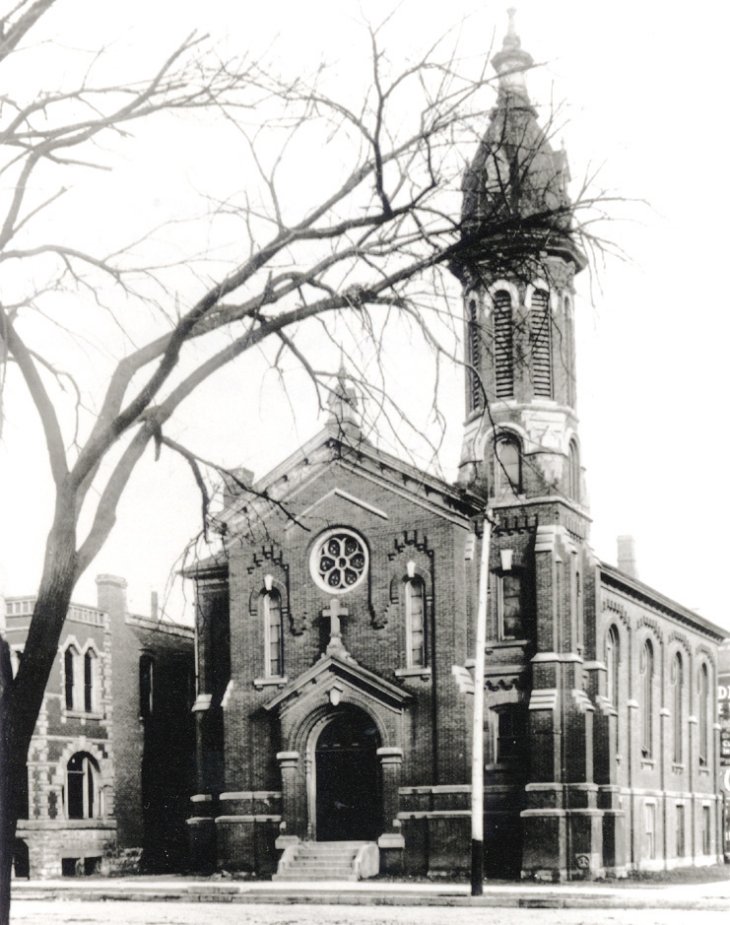Saturday
Postcard 200: Byzantine Unity Hall
Erected
in 1872 for $17,451 as a Universalist Church, this unique Byzantine edifice
with campanile spire graced
the Clinton Street and Iowa Avenue corner now
occupied by Phillips Hall on the eastern periphery of the
University of
Iowa’s Pentacrest Campus in central Iowa City. It was demolished in 1932.

Finished
the same year as neighbors across Iowa Avenue, the Universalist building at
the center of this postcard image
and St. James Hotel at right both served a
time as UI’s student union a decade before the first section of the
Iowa
Memorial Union was opened in 1925. The extant 1868 Congregational Church spire
spikes the left horizon.
|
By
Bob Hibbs
The gangly 1872 Universalist Church building was an unaffordable erection which was pestered by fire, condemned to law classes and student union use that spent much of its later life pained by instrumental music practice. Early in its 60-year lifespan it featured inspired ethics lectures and later some glorious music school recitals. Mostly, though, it just appealed to some eyes of passersby at the Clinton Street crossing of Iowa Avenue on the eastern doorstep of Old Capital. The Byzantine-style edifice capped by a towering campanile spire created a unique local image. The site now serves a portion of Phillips Hall on the University of Iowa campus across the street from Iowa Book & Supply in the Dey Building which now rests on the site of the St. James Hotel that was opened in 1872 in the considerably enlarged and extensively-renovated 1858 Workman Building. A 1916 fire destroyed the St. James. When the first lots were sold in the brand-new frontier capital of Iowa City on Aug. 19, 1839, the church corner brought the highest price of any lot sold – $750, a small fortune then. Most lots brought between $100 and $200, with proceeds helping fund Old Cap’s construction. The corner was opened for redevelopment by a June 23, 1867, fire which leveled eight buildings surrounding it, all wood-framed frontier-type structures except one. That one was Iowa City’s first-ever brick commercial building erected in 1840 of material supplied by pioneer local brick maker Savannas Johnson. The brick structure had housed Crum’s Printing shop during its entire existence. Erected during 1872 at a cost of $17,451, the Universalist building was dedicated Jan. 12, 1873, as home to a congregation which had had two previous ones in Iowa City, including a one-room log cabin purchased for $90, perhaps in 1839, and a larger building at the southeast Dubuque Street-Iowa Avenue corner in about 1844.
The
second building was razed by fire in 1860, initiating a long homeless period
ended by construction of the subject building a block away. The subject third Universalist Church was damaged extensively by fire in 1896 when the local congregation could not afford repairs, forcing its sale to its Iowa Universalist Convention. That group sold it to the Iowa Unitarian Association in 1899, forever establishing the mistaken belief that it was built as a Unitarian church. The Universalist and Unitarian groups are frequently confused – they even joke in their own literature that they frequently confuse themselves. They solved the need for subsequent distinctions by merging in 1961. The Unitarians used the subject structure only seven years before accepting $18,000 for it from a growing university which had itself been stunned just six years earlier by the loss of one-fifth of all its space to fire which razed both 1882 Medical Building and 1863 South Hall on Pentacrest on the same Sunday morning in 1901. From 1907 through completion of a new law building – now called Gilmore Hall – in 1910, the law school offered large lecture classes in newly-named Unity Hall. After limited renovation, the old church housed the student union during 1912 and 1913 to unsatisfactory reviews and a move of the union across Iowa Avenue into the upper floors of the deteriorating St. James building. Its next use was music practice, and for varied evening program events, until its demolition in 1932. Following World War II the site sported temporary classroom buildings which persisted until Phillips Hall came along in 1965. Erected as the UI College of Business Administration, it now serves as the modern languages center of liberal arts. The Unitarians applied funds from the 1906 sale of the old Universalist building toward a new building three blocks east, opening it in 1908, the same year Iowa Avenue was paved past both sites. It still houses them today on the southeast corner of Iowa Avenue and Gilbert Street. Such have Unity Hall and its lot sashayed through 164 years of Iowa City history. Next Saturday: The historic bells of Old Capitol. Bob
Hibbs collects local postcards and researches history related to them.
|
